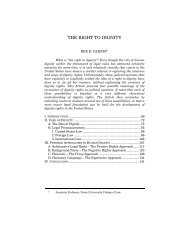A Right to Media? Lorie M. Graham - Columbia Law School
A Right to Media? Lorie M. Graham - Columbia Law School
A Right to Media? Lorie M. Graham - Columbia Law School
Create successful ePaper yourself
Turn your PDF publications into a flip-book with our unique Google optimized e-Paper software.
2010] A RIGHT TO MEDIA? 481<br />
Americans and Native American issues.” 199 The study found that the<br />
vast majority of the articles fell in<strong>to</strong> three <strong>to</strong>pic areas: casino gaming<br />
by indigenous nations, the controversy surrounding mascot team<br />
names, and what were referred <strong>to</strong> in the study as “on the res”<br />
s<strong>to</strong>ries. 200 While these <strong>to</strong>pics are worthy of coverage, they are<br />
arguably the issues most likely <strong>to</strong> engender negative feelings <strong>to</strong>wards<br />
Native Americans in the case of casinos and sports mascots, and<br />
reinforce the stereotype of the “noble savage” in the case of “on the<br />
res” s<strong>to</strong>ries.<br />
Furthermore, news pertaining <strong>to</strong> issues relating <strong>to</strong> Native<br />
American cultural survival and self-governance were reported with<br />
less frequency and often relied on misinformation and simplistic<br />
analysis of the subject matter. 201 How Native Americans are<br />
portrayed in mainstream media impacts indigenous media by way of<br />
shaping the images of Native Americans in the minds of nonindigenous<br />
peoples, who are generally the people who influence the<br />
administration of private grants and the allocation of federal funds.<br />
Ultimately, if non-indigenous Americans view indigenous peoples in<br />
a negative light or reduce their complexities <strong>to</strong> a one-dimensional<br />
caricature, there will be little support for indigenous media projects.<br />
Compounding the problem of misrepresentation is the fact that the<br />
number of Native Americans participating in the mainstream press<br />
continues <strong>to</strong> slip, and in 2005 was estimated <strong>to</strong> stand at a mere 295<br />
people. 202<br />
It seems unlikely that representation and participation of<br />
Native Americans in mainstream media will improve without<br />
increased federal guidance and involvement. Not surprisingly,<br />
resistance <strong>to</strong> the regulation of mainstream media is strong in the<br />
United States with much emphasis placed on one aspect of the right<br />
<strong>to</strong> media, freedom of expression, and little attention paid <strong>to</strong> the other<br />
key components, including the right <strong>to</strong> information and nondiscrimination.<br />
It may be that the concerns over regulation are a bit<br />
overblown in that the Federal Communications Commission (FCC)<br />
already has the authority <strong>to</strong> regulate media, at least with respect <strong>to</strong><br />
radio, television, wire, satellite, and cable. Perhaps instituting<br />
something similar <strong>to</strong> the U.S. Fairness Doctrine could be one way <strong>to</strong><br />
199. Id. at VII.<br />
200. Id. at VIII.<br />
201. Id. at XI–XIII.<br />
202. HearUsNow.org, Communities: Native American,<br />
http://www.hearusnow.org/other/8/nativeamerican (last visited Feb. 5, 2010).















